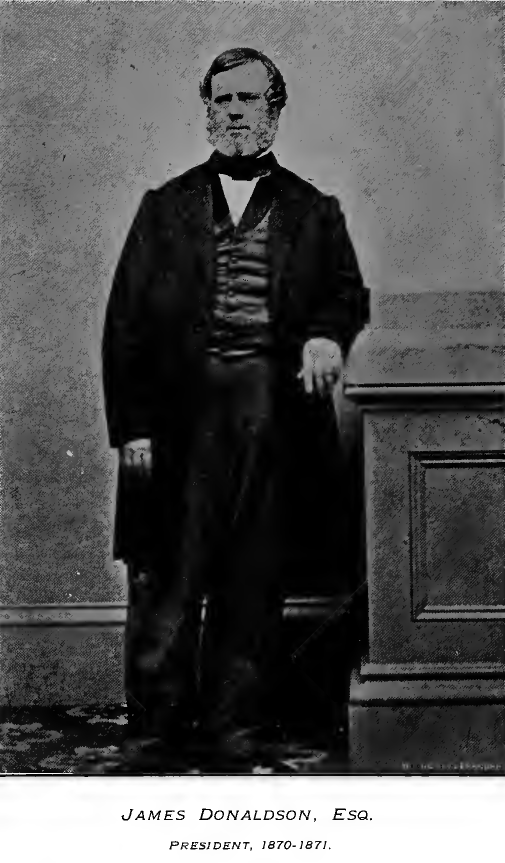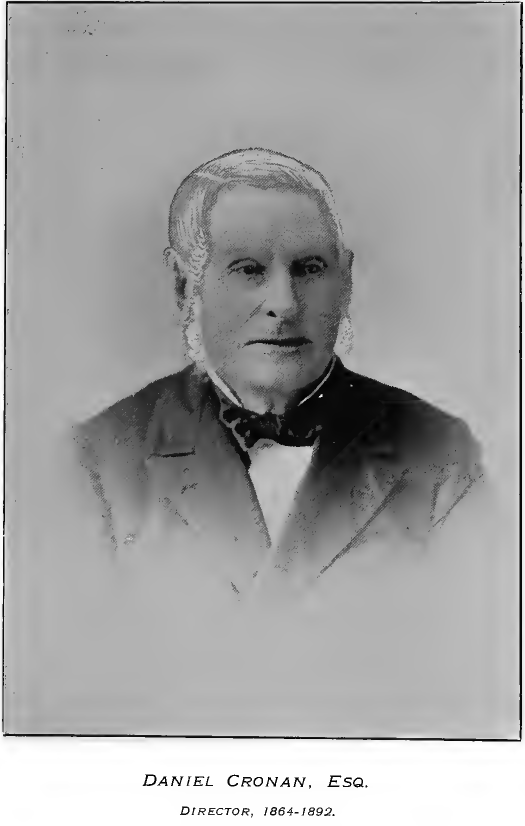|
THE Hon. M. B. Almon
resigned the Presidency on 17th September, 1870. Two days later Mr.
James Donaldson, who, as Vice President, had been acting for him for
some months, was chosen to fill his place, serving until the annual
meeting of March, 1871, when Mr. John Doull was elected. On 25th August,
1871, Mr. A. M. Uniacke was elected Vice-President, and in March, 1872,
was chosen President, with Mr. J. S. Maclean, Vice-President.
The new management infused fresh vigor into the institution, the
resulting profits enabling the Directors to report to the Shareholders
in March, 1872, that both as respects its finances and credit it may now
be said to have recovered from the effects of the loss by its late
“Cashier.”
After 1870 the Bank closed its books on 31st December instead of a month
later, and at the annual meeting on 6th March, 1872, a new set of
Bye-laws was adopted in accordance with the general banking law of
Canada, which had taken the place of its charter. By those regulations
the number of Directors was reduced to seven, and the stock
qualification of a Director raised to three thousand dollars. In
February, 1873, the accumulated earnings were sufficient to allow a
transfer from Reserve Fund to Capital Account of $55,066.67, which
restored the latter to the figure at which it stood prior to October,
1871, viz.: $560,000, Old Nova Scotia Currency, and the Directors were
empowered to withdraw from the profits to be earned in 1873, whenever
they saw fit, the sum of $14,933.33, so as to raise the capital to
$560,000 Canada Currency. In the summer of 1873 the capital was
increased to $750,000 by public sale of new stock—the prices averaging
about $242 per share of $200.
Mr. J. S. Maclean became President and Mr. John Doull Vice President in
1874.
About this time the work of opening Agencies began in earnest. North
Sydney had been opened in November, 1867. Kentville Agency commenced
operations in July, 1870; Amherst in June, 1871. In June, 1874, an
Agency was opened at St. John, N. B., in the Maritime Bank Building,
over the Bank of Montreal offices ; and on the 6th May, 1875, Mr. Thomas
Fyshe, to whom much of the Bank’s subsequent progress is due, there
entered the service of the Bank as Agent. The Cushing Building on Prince
William Street was bought and occupied the year following and until it
was burned in the great fire of June, 1877. Two months later the Board
had accepted plans and specifications for the present building, which
stands on the same site. The lot adjoining the Banking House at Halifax
had been purchased in 1874, and a building with sandstone front erected.
An Agency was opened at Annapolis for the second time in December, 1876;
Bridgetown and Digby were started as Sub-Agencies to it early the next
year. Liverpool was opened (for the second time) in June, 1879.


At the annual meeting
in February, 1876, the number of Directors was changed from seven to
five—Messrs. Donaldson and Uniacke having resigned their seats during
the preceding year.
Mr. Menzies, who had been granted an extended furlough on account of
declining health, resigned the position of Cashier in March, 1876, being
then in France; and died shortly afterward.
Mr. Thomas Fyshe, who had been acting in that capacity, was appointed
Cashier on 5th April, and a thorough systemizing of the Bank’s growing
business was begun.
The first visit of Barnum’s circus to Halifax was the means of
introducing the Bank of Nova Scotia to a new adversary, the sneak thief.
On 1st August, 1876, the Cashier being out of town on an inspecting
trip, the entire staff, unable to resist the temptation to gratify their
curiosity, quitted their posts and stood on the doorsteps, to see the
passing show. They of course barred the public entrance, but a man of
decent appearance applied to the janitor’s wife at the north door for
permission to go into the cellar to search for some article which he
said he had dropped through the iron grating in the sidewalk. Being at
once admitted, he descended the janitor’s stair, crossed the cellar,
gained the banking room by its stair, helped himself to all the money he
could conveniently hide about his person, $21,597.51, and went back by
the way he had come. Two men were arrested on suspicion that night at
Bedford—a few miles from town—but, after two trials, acquitted,
sufficient evidence to convict not being obtainable. These two men have
since “served time” for other thefts; and the principal actor has
recounted to a detective how this robbery had been planned and carried
out.
The general depression resulting from the collapse of the industry which
principally had brought Nova Scotia, New Brunswick and Prince Edward
Island before the world—that of wooden shipbuilding—was beginning to be'
felt about 1877. Failures became the order of the day, bringing heavy
losses to the banks. Indeed, so severe was the depression and so
considerable the losses that the operations of the banks of these
provinces, taken in the aggregate, produced a net return for the ten
years ending with 1886, of only about four per cent, per annum on the
total capital employed. With three exceptions—the Bank of Nova Scotia
being one — no Bank in the Maritime Provinces earned enough to pay the
dividends declared: so that the banking capital was somewhat less in
1886 than in 1874.
The Bank of Liverpool (N. S.) went into liquidation in June, 1879, the
Bank of Nova Scotia being the principal creditor. The latter Bank, in
the person of its Cashier, was afterwards appointed assignee, and after
much litigation wound up the affairs of the former.
In May, 1881, the Bank made a free grant to the City of Halifax of a
considerable piece of land, which it owned, to help in establishing
Point Pleasant Park. |
